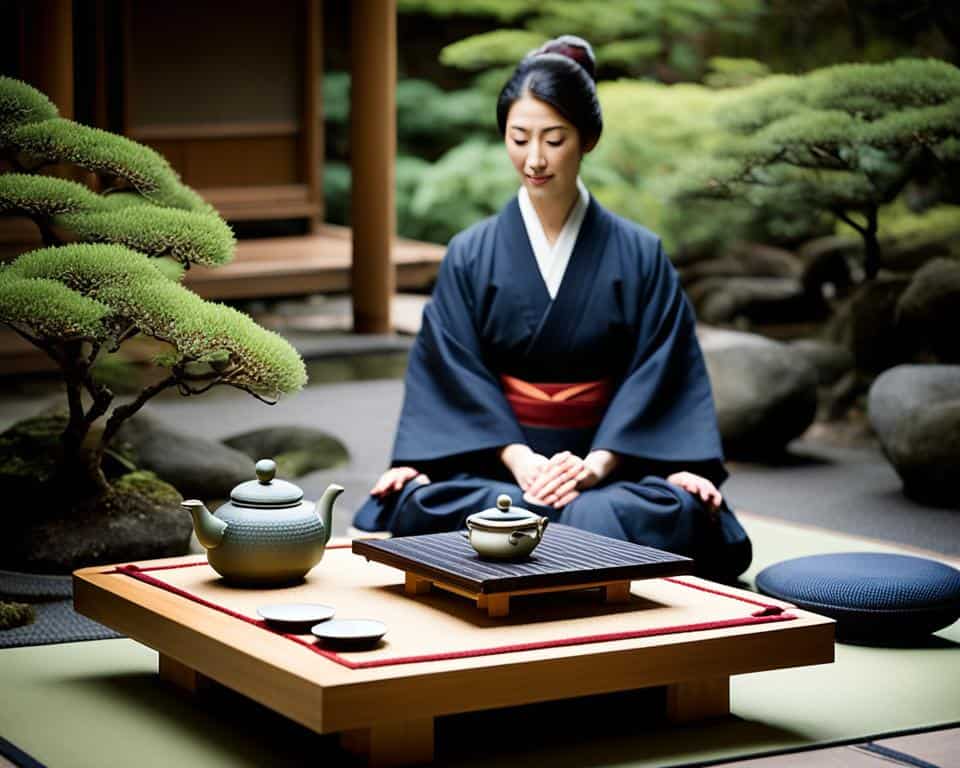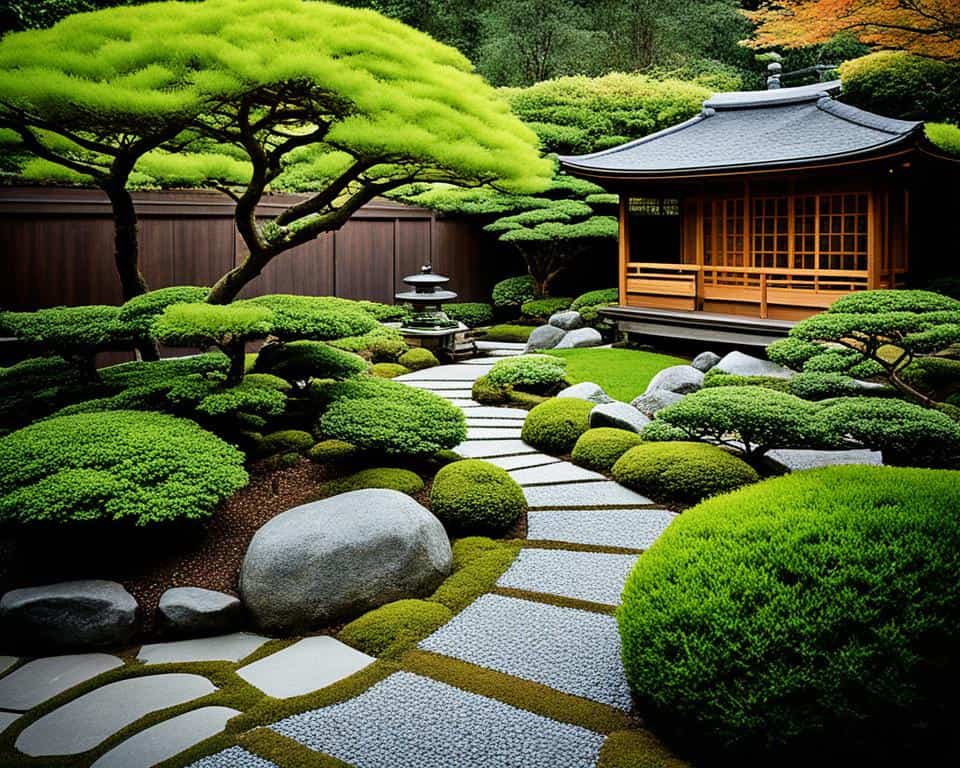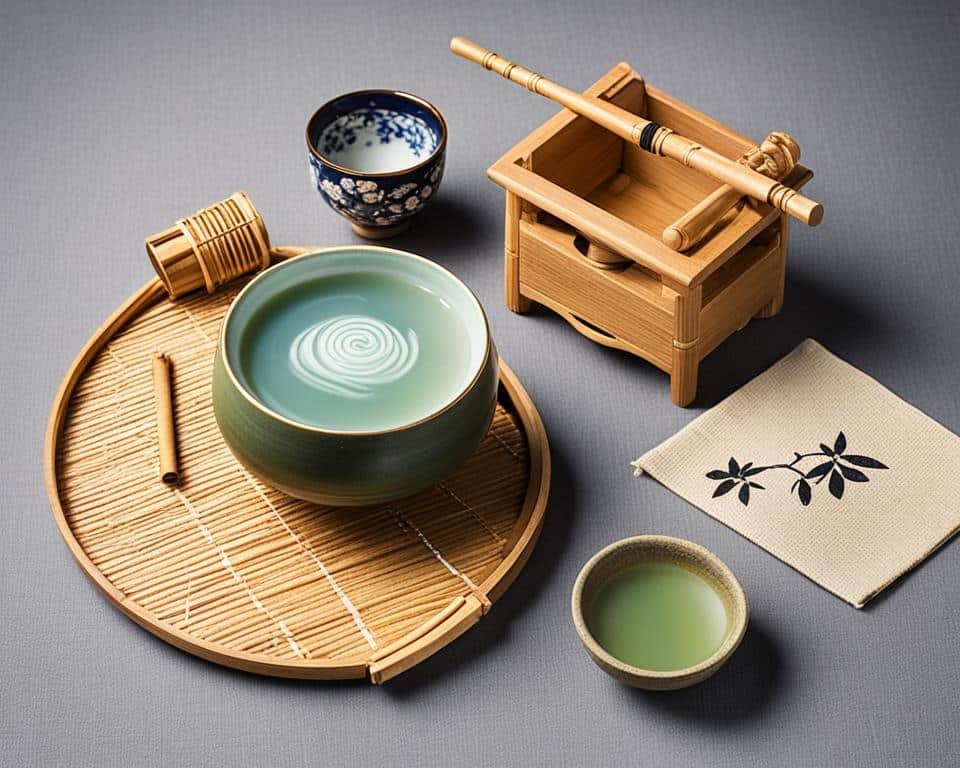
The Japanese tea ceremony shows the beauty of Japanese tea culture. It’s more than a drink. Traditional tea connects the past to the present. The Samurai started these rituals. They involve matcha, genmaicha, and sencha. Now, they’re an art form. This art brings peace and welcomes guests. It’s a break from our busy lives.
Many young women are taking classes on the tea ceremony. They love its elegance. Mastering it adds to their grace. The ceremony happens in a beautiful garden. Guests enter through a small door. They go into a room with tatami mats. Wearing a kimono or yukata makes it special. This setting helps one meditate.
Key Takeaways
- The Japanese tea ceremony, known as “sadō” or “chadō,” is important in Japan’s history and everyday life.
- Traditional tea is an art of calmness and respect. Its roots are in the Samurai era.
- Matcha, genmaicha, and sencha are key to the ceremony. Each tea is special and prepared a certain way.
- The tea ceremony settings and clothes aim to show simplicity, elegance, and a bond with nature.
- The ceremony’s spirit of hospitality and mindfulness lets people fully enjoy the moment.
The Historical Significance of Japanese Tea Ceremonies
The culture of Japanese tea ceremonies is deep. It goes beyond its peaceful look. It is a key part of Japan’s history. The story of matcha tea and other teas is linked with Zen Buddhism. It also connects with big cultural changes over time.
The Journey of Tea from China to Japan
Chinese monks first loved tea for its health benefits. Then, in the 8th century, it arrived in Japan. Japanese priests and nobles drank it as a health drink. Traditional Japanese tea soon became a sign of high status and good spiritual health.
The Influence of Zen on Tea Ceremonies
Zen monks adopting tea was key to the tea ceremonies’ spirit. In the Muromachi Period, Zen shaped these rituals deeply. It brought Zen-inspired tea parties. These parties focused on being mindful and simple.
Sen no Rikyu and the Way of Tea (Chado)
Sen no Rikyu had a big impact on the Japanese tea ceremony. He loved rustic simplicity and spiritual peace. His ideas are the core of big schools like Omotesenke and Urasenke. They still guide tea practices. These practices celebrate the beauty in being simple.
Cultural Nuances of the Tea Ceremony Experience
The Japanese tea ceremony is known for its calming and beautiful aspects. It blends many elements of traditional culture. This includes attire, garden settings, and the design of the tea space. Every part has deep historical meaning. They are all chosen to make the tea experience peaceful.
Tea Ceremony Attire: From Kimonos to Modern Dress
What you wear is key to the tea ceremony. It shows respect and honor. Traditional outfits like kimonos and yukatas are often worn. They show the cultural past and add to the ceremony’s formality and beauty. These outfits are more than just clothes. They help guests feel connected to the ceremony’s calm spirit.
Role of Gardens and Tranquility in Tea Ceremonies
The tea ceremony garden aims to make you feel at peace and thoughtful. It starts your journey even before you enter the tea house. Paths through lovely gardens show the beauty of the seasons. They lead to a simple tea house. The garden isn’t just pretty. It links nature to health and cleanses the spirit and body.
Understanding the Tatami Room and Guest Etiquette
The ceremony happens in a tatami room. Here, you must bow to enter, showing humility. This act means leaving outside worries behind. In the room, the tatami mats and tea tools are placed just right. This setup helps guests stay focused and mindful. Guests must move and speak in special ways. This respects the host and the peaceful setting.

Japanese Tea: A Symbol of Hospitality and Mindfulness
The Japanese tea ceremony is more than drinking tea. It shows deep hospitality and mindfulness. It is a part of Japanese culture. It uses organic Japanese tea. This makes a peaceful atmosphere. It helps us live in the moment. The ceremony has many tea benefits. It makes us peaceful and connects us with others.
Every action in this ceremony has meaning. It is all about making peace and respect. The host’s movements lead to mindfulness. This practice values purity, respect, and harmony. It’s not only about good tea. It is also about valuing now with others.
The ceremony’s spirit has four main principles. They are harmony (wa), respect (kei), purity (sei), and tranquility (jaku). These guide how everyone acts. They help each person find calm. Everyone can forget their troubles for a while.
- Harmony is kept by balancing nature in the tea garden and room.
- Respect comes from how everyone behaves, honoring the tea, guests, and hosts.
- Purity is about keeping things clean and clearing your mind before the ceremony.
- Tranquility is the calm state we reach at the end when our minds and spirits are clear.
The Japanese tea ceremony is very special. It helps with our well-being. It offers peace in our busy lives. We dive into a calm experience. Drinking tea turns into a mindful act. This helps us see the simple beauty in life.
The Aesthetics and Tools of Japanese Tea Ceremonies
The Japanese tea ceremony is more than drinking tea. It’s a deep cultural experience. Tools and aesthetics shape this ceremony. They show the beauty and heritage of Japanese tea.
The Art of Selecting and Using Tea Utensils
Finding the right tools for a tea ceremony is a special skill. It requires knowing their practical and symbolic sides. The chawan, chasen, and chashaku must be high quality to enhance the tea. Craftsmen today make these tools with care. They aim to meet tea masters’ standards and bring in new styles.
Exploring the Visual Harmony of Tea Ceremony Arrangements
Setting up a tea ceremony focuses on harmony and calm. The placement of dinnerware and use of space matter a lot. Each part, from matcha to kaiseki, adds to a visual and tasty story. This shows a deep respect for Japanese tea culture and mindful setup.
Preserving Tradition Through Modern Tea Utensils and Wares
Tea ceremony tools have stayed the same for years. But now, artisans are adding modern touches. Collections like Pekoe mix old and new. They let tea lovers enjoy tea rituals every day without losing tradition. This keeps tea culture alive for the future.

The act of whisking matcha and presenting hojicha in beautiful ceramics is key to tea culture. This mix of old and new keeps the tea ceremony’s spirit and beauty alive. It’s an ongoing tradition that touches our senses and hearts.
Conclusion
In the heart of Japan, tea ceremonies are a key cultural event. They show the deep roots of tradition. These events draw from Zen Buddhism, showing their importance today. They highlight cultural value, being mindful, and simple beauty.
Each movement and sip of tea, like matcha or genmaicha, connects us to history. It’s a respectful practice filled with meaning.
The teas used bring a taste of Japan’s lands. They link each sip to Japan’s cultural story. Tea masters mix tradition with the present in their brews. This ritual keeps history alive while fitting into today’s world.
Tea ceremonies offer peace amid our busy lives. They happen in rooms with tatami mats or at home. Choosing the tea and setting up utensils is key. This makes the experience special.
This tradition touches people worldwide. It invites everyone to experience tea culture. It’s an art that shows the deep meaning of Japanese tea rituals.
FAQ
What is the Japanese tea ceremony?
The Japanese tea ceremony is known as “sadō” or “chadō”. It is a traditional activity inspired by Zen Buddhism. It involves the careful preparation, serving, and drinking of matcha. Matcha is a fine powdered green tea. The ceremony focuses on harmony, respect, purity, and tranquility.
What types of tea are used in Japanese tea ceremonies?
Matcha is the main tea used in these ceremonies. It is a fine powder made from special green tea leaves. Sometimes, teas like sencha or other specialized teas might be used. This depends on the ceremony’s formality.
What does a traditional Japanese tea ceremony involve?
In a traditional ceremony, the host performs precise actions. They prepare the tea space and clean the utensils. The creation of the tea is also methodical. Guests have specific roles that show respect and appreciation. Everyone is mindful and attentive during the process.
What are the health benefits of Japanese tea?
Japanese green teas, especially matcha, sencha, and genmaicha, are full of antioxidants. These antioxidants help fight free radicals. This can lower disease risks. They also boost mental alertness, heart health, and metabolism.
How can I perform a Japanese tea ceremony at home?
To do a tea ceremony at home, get the right utensils. These include a tea bowl, whisk, scoop, and matcha powder. Learn the traditional steps or make your own ceremony focusing on mindfulness and enjoying the tea.
What is the cultural significance of the Japanese tea ceremony?
The ceremony is a key cultural ritual in Japan. It reflects important Japanese ideals like simplicity and appreciating the moment. It shows the host’s hospitality and strengthens social bonds. The ceremony shows deep aspects of Japanese culture and traditions.
Are there different styles or schools of Japanese tea ceremony?
Yes, there are many tea ceremony schools, each unique. The main ones are Omotesenke, Urasenke, and Mushakojisenke. They all follow the ideas of the tea master Sen no Rikyu.
Can Matcha and other Japanese teas be enjoyed outside of the tea ceremony?
Yes, Matcha and teas like sencha and genmaicha are great for everyday enjoyment. Each tea has its own unique taste and brewing style. This allows for personal enjoyment in many settings.
What attire should one wear to a Japanese tea ceremony?
Wearing modest clothes is key for a tea ceremony. Kimonos are common for both men and women. For casual events, simple western clothes are alright. Just make sure your clothes are comfortable for sitting on tatami mats.

[…] comes from old tea ceremonies in Japan. It’s about loving what’s simple and quiet. In haikus, it means […]
[…] the moment you step foot inside, you will be greeted with a warm smile and a cup of traditional Japanese tea. The rooms are spacious and elegantly decorated, with tatami mats and sliding doors that open up to […]